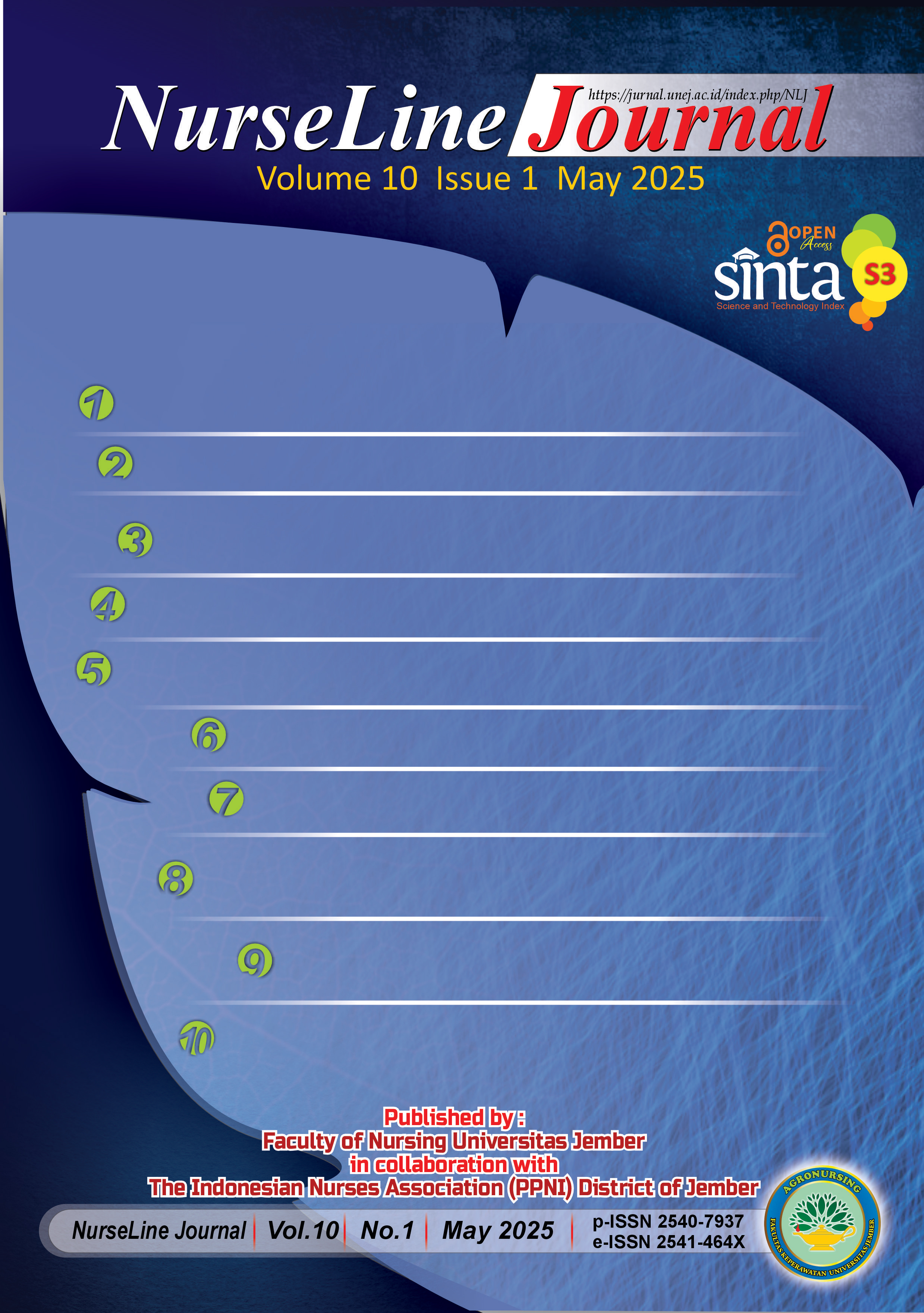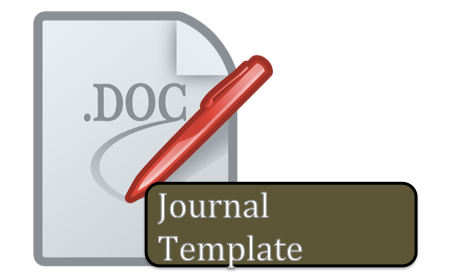Determinants of Health Promoting Lifestyle Among Undergraduate Nursing Students in Indonesia: A Post-Pandemic Analysis
DOI:
https://doi.org/10.19184/nlj.v10i1.53697Keywords:
COVID-19, Demographic factors, Lifestyle, Nursing studentsAbstract
Background: Maintaining a health-promoting lifestyle is essential for nursing students, as it supports their well-being and prepares them to serve as role models in clinical practice. Objective: Study aimed to identify determinants of health-promoting lifestyle profiles among undergraduate nursing students. Methods: A cross-sectional design, 132 nursing students from a private university in North Sulawesi Province, convenience sampling. Instrument was HPLP-II. Analyzed using independent t-tests, one-way ANOVA, Pearson correlation, hierarchical linear regression. Results: Highest mean score was in spiritual growth with a mean of 2.89 (SD=0.47), while health responsibility had lowest score of 1.95 (SD=0.46). Overall lifestyle score was 2.41 (SD=0.33). Regression analysis revealed that variables exercise (ß=0.251; p=0.004), religiosity (ß=0.245; p=0.005), history of COVID-19 infection (ß=0.169; p=0.043), COVID-19 vaccination status (ß=0.179; p=0.032) significantly predicted healthpromoting lifestyle behaviors, with an explanatory power of 18.4%. Conclusion: Targeted interventions should focus on enhancing spiritual growth, promoting regular physical activity, providing ongoing health education tailored to both pandemic, post-pandemic contexts to support development of healthier lifestyles among nursing students
Downloads
References
Admi, H., Moshe-Eilon, Y., Sharon, D., & Mann, M. (2018). Nursing students’ stress and satisfaction in clinical practice along different stages: A cross-sectional study. Nurse Education Today, 68(September), 86–92. https://doi.org/10.1016/j.nedt.2018.05.027
Akkuş, Y., & Karabağ Aydın, A. (2022). Determining the relationship between spirituality and perceptions of care in nursing students: A cross-sectional study. Perspectives in Psychiatric Care, 58(4), 2079–2087. https://doi.org/10.1111/ppc.13034
Arfianto, M. A., Haqqiyah, S. N., Widowati, S., & Ibad, M. R. (2023). Correlation of spiritual well-being and stress level in college students: A correlational study. IJNP (Indonesian Journal of Nursing Practices), 7(1), 26–36. https://doi.org/10.18196/ijnp.v7i1.17914
Bani, V. D., Gusti, P. K., Rawul, M. E., Pakpahan, M., & Silitonga, E. (2023). Nursing students’ knowledge and attitude in relation to COVID-19 prevention behavior. Revista Brasileira de Enfermagem, 76(Suppl 1), 1–6. https://doi.org/10.1590/0034-7167-2022-0588
Binks, H., Vincent, G. E., Irwin, C., Heidke, P., Vandelanotte, C., Williams, S. L., & Khalesi, S. (2020). Associations between sleep and lifestyle behaviours among Australian nursing students: A cross-sectional study. Collegian, 28(1), 97–105. https://doi.org/10.1016/j.colegn.2020.02.013
Borle, P. S., Parande, M. A., Tapare, V. S., Kamble, V., & Bulakh, P. (2017). Health-promoting lifestyle behaviours of nursing students of a tertiary care institute. International Journal of Community Medicine and Public Health, 4(5), 1768–1773. https://doi.org/10.18203/2394-6040.ijcmph20171799
Butterworth, K., Rajupadhya, R., Gongal, R., Manca, T., Ross, S., & Nichols, D. (2018). A clinical nursing rotation transforms medical students’ interprofessional attitudes. PLoS ONE, 13(5), 1–11. https://doi.org/10.1371/journal.pone.0197161
Capan, M., Bigelow, L., Kathuria, Y., Paluch, A., & Chung, J. (2024). Analysis of multi-level barriers to physical activity among nursing students using regularized regression. PLoS ONE, 19(5 May), 1–18. https://doi.org/10.1371/journal.pone.0304214
Chow, S., Lam, K., Lie, S., Mak, K., Mong, K., So, C., & Yuen, W. (2018). Do demographic factors and a health-promoting lifestyle influence the self-rated health of college nursing students? BMC Nursing, 17(50), 1–9. https://doi.org/10.1186/s12912-018-0322-y
de Almeida, L. Y., de Oliveira, J. L., de Almeida, J. C. P., Dadalte, A. C., Rodrigues, S. B., Fantacini, C. M. F., Guandolini, R. H., & de Souza, J. (2020). Physical activity and leisure in the daily life of nursing students. Open Journal of Nursing, 10(09), 918–928. https://doi.org/10.4236/ojn.2020.109063
Dwidiyanti, M., Munif, B., & Handayani, F. (2022). SIDE: An application-based happy spiritual intervention for emotion regulation among nursing students during online learning. Jurnal Aisyah: Jurnal Ilmu Kesehatan, 7(4), 1339–1344. https://doi.org/10.30604/jika.v7i4.1630
Fabbris, J. L., Mesquita, A. C., Caldeira, S., Carvalho, A. M. P., & Carvalho, E. C. de. (2017). Anxiety and spiritual well-being in nursing students: A Cross-sectional study. Journal of Holistic Nursing, 35(3), 261–270. https://doi.org/10.1177/0898010116655004
Fashafsheh, I., Al-Ghabeesh, S. H., Ayed, A., Salama, B., Batran, A., & Bawadi, H. (2021). Health-promoting behaviors among nursing students: Palestinian perspective. INQUIRY: A Journal of Medical Care Organization, Provision and Financing, 58, 1–5. https://doi.org/10.1177/00469580211018790
Faul, F., Erdfelder, E., Buchner, A., & Lang, A. G. (2009). Statistical power analyses using G*Power 3.1: Tests for correlation and regression analyses. Behavior Research Methods, 41(4), 1149–1160. https://doi.org/10.3758/BRM.41.4.1149
Fung, J. T. C., Chan, S. L., Takemura, N., Chiu, H.-Y., Huang, H.-C., Lee, J.-E., Preechawong, S., Hyun, M. Y., Sun, M., Xia, W., Xiao, J., & Lin, C.-C. (2023). Virtual simulation and problem-based learning enhance perceived clinical and cultural competence of nursing students in Asia: A randomized controlled cross-over study. Nurse Education Today, 123(April), 105721. https://doi.org/10.1016/j.nedt.2023.105721
Gadi, N., Saleh, S., Johnson, J. A., & Trinidade, A. (2022). The impact of the COVID-19 pandemic on the lifestyle and behaviours, mental health and education of students studying healthcare-related courses at a British university. BMC Medical Education, 22(1), 1–9. https://doi.org/10.1186/s12909-022-03179-z
Geok, S. K., Salimah, J., Leong, O. S., & Lam, S. K. (2018). Physical activity and health promoting lifestyle among bachelor of nursing students in Malaysia. Journal of Pharmacy and Technology, 11(7), 2906–2910. https://doi.org/10.5958/0974-360X.2018.00535.8
Gipson, C. S., Deal, B., & Skinner, M. (2024). Examining well-being and healthy lifestyle interventions among nursing students worldwide: A scoping review. Journal of Holistic Nursing, 1–19. https://doi.org/10.1177/08980101241283856
Heinze, G., & Dunkler, D. (2017). Five myths about variable selection. Transplant International, 30(1), 6–10. https://doi.org/10.1111/tri.12895
Hosseini, M., Ashktorab, T., Taghdisi, M. H., Vardanjani, A. E., & Rafiei, H. (2015). Health-promoting behaviors and their association with certain demographic characteristics of nursing students of Tehran City in 2013. Global Journal of Health Science, 7(2), 264–272. https://doi.org/10.5539/gjhs.v7n2p264
Jardon, C., & Choi, K. R. (2024). COVID-19 experiences and mental health among graduate and undergraduate nursing students in Los Angeles. Journal of the American Psychiatric Nurses Association, 30(1), 86–94. https://doi.org/10.1177/10783903211072222
Jin, J. (2023). Factors influencing spiritual health among nursing students in the prolonged COVID-19 situation. International Journal of Environmental Research and Public Health, 20(4). https://doi.org/10.3390/ijerph20043716
Kalal, N., & Rana, N. (2022). Perspectives: Nursing students and COVID-19: Challenges and coping strategies. Journal of Research in Nursing, 27(5), 494–498. https://doi.org/10.1177/17449871221114547
Kim, K. A., Hyun, M. S., De Gagne, J. C., & Ahn, J. A. (2023). A cross-sectional study of nursing students’ eHealth literacy and COVID-19 preventive behaviours. Nursing Open, 10(2), 544–551. https://doi.org/10.1002/nop2.1320
Koa, A. J. A. F., Chou, C. C., Lindayani, L., & Wang, C. J. (2024). Exploring barriers to physical activity participation among female nursing students adhering to specific social-cultural norms in Indonesia: A qualitative study. Belitung Nursing Journal, 10(4), 438–447. https://doi.org/10.33546/bnj.3370
Kusol, K., & Kaewpawong, P. (2023). Perceived self-efficacy, preventive health behaviors and quality of life among nursing students in Nakhon Si Thammarat Province, Thailand during the COVID-19 pandemic. Patient Preference and Adherence, 17(August), 1989–1997. https://doi.org/10.2147/PPA.S424611
Kwon, S. J., Kim, Y., & Kwak, Y. (2024). Nursing students’ clinical practice education experience during the COVID-19 pandemic: A qualitative study. BMC Nursing, 23(1), 1–8. https://doi.org/10.1186/s12912-024-01730-5
Listavia, F., Eko, C., & Agustinus. (2021). Nursing students as a role model for their families in the midst of the COVID-19 pandemic: A qualitative study. In B. Murti (Ed.), The 8th International Conference on Public Health (p. 118). https://doi.org/10.26911/AB.Promotion.ICPH.08.2021.50
Macedo, T. T. S. de, Sheets, D., Ribeiro, F. M. S. e S., Santos, C. A. de S. T., Patrão, A. L., & Mussi, F. C. (2023). Sociodemographic and academic factors associated with unhealthy lifestyle among Brazilian nursing students. Nursing & Health Sciences, 25(2), 239–246. https://doi.org/10.1111/nhs.13021
Ministry of Education and Culture Republic of Indonesia. (2022). Statistik pendidikan tinggi. https://pddikti.kemdiktisaintek.go.id/statistik
Munif, B., Dwidiyanti, M., Sholihin, Pamungkas, A. Y. F., Rudiyanto, & Prasetyawan, R. D. (2024). Differences between spiritual mindfulness and mindfulness caring in reducing academic pathological stress in nursing students. Malaysian Journal of Nursing, 15(3), 126–137. https://doi.org/10.31674/mjn.2024.v15i03.015
Nakagawa, H., & Sasai, H. (2021). Nursing students’ practicums during the covid-19 crisis and the effect on infection-prevention behavior in students: A mixed-method approach. Medicina (Lithuania), 57(12), 1–13. https://doi.org/10.3390/medicina57121354
Özden, G., & Parlar Kiliç, S. (2021). The effect of social isolation during COVID-19 pandemic on nutrition and exercise behaviors of nursing students. Ecology of Food and Nutrition, 60(6), 663–681. https://doi.org/10.1080/03670244.2021.1875456
Parviniannasab, A. M., Bijani, M., & Dehghani, A. (2022). The mediating role of psychological capital in relations between spiritual well-being and mental health among nursing students. BMC Psychology, 10(1), 1–7. https://doi.org/10.1186/s40359-022-00935-0
Payaprom, Y., Manasatchakun, P., & Chandeekaewsakoon, S. (2024). Predictive power of health literacy on COVID-19 preventive behaviors of nursing students. Nursing Science Journal of Thailand, 42(4), 27–40. https://he02.tci-thaijo.org/index.php/ns/article/view/269869/185670
Pender, N. J., Murdaugh, C. L., & Parsons, M. A. (2015). Health promotion in nursing practice (7th ed.). Pearson Education.
Putri, A. S., Sunarya, C. E., & Waluyo, A. (2023). Nursing students’ spirituality and their perception of spirituality and spiritual care. Indonesian Nursing Journal of Education & Clinic (INJEC), 8(1), 3–11. https://doi.org/10.24990/injec.v8i1.484
Rohde, G., Johannessen, B., Maaseide, M., Flateland, S., Skisland, A. V., Moi, E. B., & Haraldstad, K. (2023). Being a nursing student during the coronavirus pandemic: A mixed methods study. BMC Nursing, 22(1), 1–10. https://doi.org/10.1186/s12912-023-01218-8
Sari, D. P., & Sutarto, S. (2023). Academic stress coping strategies using spiritual approaches to improve student resilience. Psikis: Jurnal Psikologi Islami, 9(1), 101–111. https://doi.org/10.19109/psikis.v9i1.14420
Savitsky, B., Findling, Y., Ereli, A., & Hendel, T. (2020). Anxiety and coping strategies among nursing students during the covid-19 pandemic. Nurse Education in Practice, 46(May), 1–7. https://doi.org/10.1016/j.nepr.2020.102809
Shehadeh, J., Hamdan-Mansour, A. M., Halasa, S. N., Hani, M. H. B., Nabolsi, M. M., Thultheen, I., & Nassar, O. S. (2020). Academic stress and self-efficacy as predictors of academic satisfaction among nursing students. The Open Nursing Journal, 14(1), 92–99. https://doi.org/10.2174/1874434602014010092
Sitorus, N. (2021). Gaya hidup sehat mahasiswa Sekolah Tinggi Ilmu Kesehatan di Bandung. Jurnal Ilmu Kesehatan Immanuel, 14(2), 55–62. https://doi.org/10.36051/jiki.v14i2.129
Son, C., Hegde, S., Smith, A., Wang, X., & Sasangohar, F. (2020). Effects of COVID-19 on college students’ mental health in the United States: Interview survey study. Journal of Medical Internet Research, 22(9), 1–14. https://doi.org/10.2196/21279
Walker, S., Sechrist, K., & Pender, N. (1995). Health promotion model - Instruments to measure health promoting lifestyle: Health-Promoting Lifestyle Profile [HPLP II] (Adult Version). In Unpublished manuscript. https://deepblue.lib.umich.edu/handle/2027.42/85349
Downloads
Published
Issue
Section
License
Copyright (c) 2025 NurseLine Journal

This work is licensed under a Creative Commons Attribution-ShareAlike 4.0 International License.








